by Prof. R. Balasubramanian
Formerly of Sri Aurobindo School of Eastern & Western Thought, Pondicherry University, Pondicherry
Sri Sankara’s insistence on the importance of Jnanayoga as the means to the attainment of Brahman-realization is based on a very simple but profound truth with which we are familiar in our day-to-day experience. But it was given to a great mastermind like Sankara to evolve from it a theory of great metaphysical significance taking his stand on the authority of the Upanishads. In all his numerous writings, whether they be his monumental commentaries on the Upanishads, or on the Gita, or on the Brahma-sutra or in his celebrated minor works, Sankara sticks to this basic position with unswerving conviction. It is a matter of common knowledge that when we are ignorant about something we endeavour to remove that ignorance by gaining the true knowledge of that object. Take the familiar case of mistaking a rope which is in front for a snake. Not knowing the real nature of the object in front, a person thinks that it is a snake and begins to run away in fear. His ignorance of the real nature of the object is the cause of his thinking of it as a snake and the subsequent reactions in him like sweating, running away in fear, etc. It is not enough if he is told that the object in front is not a snake. The statement that it is not a snake does not serve to remove his ignorance of the object in front. Perhaps he has known to some extent what it is not. But this does not mean that his ignorance has been removed. The very fact that he still entertains doubts about it, and is keenly desirous of knowing what it is, shows that he is still ignorant of it; and his ignorance can be removed only by attaining the knowledge of the object in front, viz. the rope. In short, it is knowledge and knowledge alone that removes ignorance in the same way as light removes darkness.
(Almabodha, Verse-3) Sankara’s contention that Jnana-yoga is the direct means to the attainment of Brahman-realization, which is release, is thus based upon what we experience in our day-to-day life. He has shown that this basic principle, namely, that knowledge is the antidote to ignorance, holds good not only with regard to removing our ordinary ignorance as exemplified in our mistaking a rope for a snake, but also in overcoming the metaphysical or foundational ignorance from which we suffer. Man finds himself caught up in the ever-revolving wheel of activity, which makes him sick at heart. Not being able to escape from it, he plunges deep into it developing time-consciousness. Every thing that he does is according to the time schedule. Even the relaxation, which he is supposed to have, is according to the time schedule. All the time, he is involved in action, whether outward or inward. In the words of Lord Krishna: “None verily, even for an instant, ever remains doing no action; for every one is driven helpless to action by the energies born of Nature.”

(The Gita, 3-5)
It is the desire (Kama) that is the cause of all our action, good or bad. It does not matter whether we do an action enjoined by Scripture or prohibited by it. In every case there is the desire to attain some end or other; and it is desire which prompts one to do some action through deed, speech, or thought. What then, is the cause of desire? According to Sankara, desire arises on account of the ignorance of the real nature of the Self. Desire relates to the not-Self. When a person attains the knowledge of the Self as non-different from the non-dual-Brahman, when a person realizes that there is only the Self and nothing else separate from it that can be desired, he becomes one without desires (akamah), one who is free from desires (nishkamah). Since a man who has realized his identity with all has nothing to desire, he cannot perform rites. The ignorance of the real nature of the non-dual Self is the root cause of bondage, and hence it is characterized as foundational or metaphysical ignorance. The attainment of Brahman-knowledge, which is the supreme good, marks the complete cessation of samsara and of its cause.

(Sankara’s Introduction to the Gita.) The casual chain, therefore, proceeds from ignorance to desire, and from desire to action, and so on.
A complete enumeration of the several links of the causal chain will be as follows: from erroneous cognition, desire and aversion arise: from these there arises action (pravrtti) towards dharma and adharma; and from action their results birth (ianma) and consequent on birth there is misery. Liberation consists in the removal of avidya and its results. The Nyaya-sutra (1-1-2), which Sri Sankara quotes in this context, clearly sets forth the causal chain starting from avidya and ending in dhuhkha

(Narayana Sutra1-1-2)
In the Upadesa Sahasri, Sankara beautifully sums up the way in which the casual chain works out starting from avidya. He says: “Actions bring about one’s connection with the body; when the connection with the body has taken place, pleasure and pain most surely follow; thence come attraction and repulsion, from them actions follow again, as the results of which merit and demerit appertain to an ignorant man, which again are similarly followed by the connection with the body. This transmigratory existence is thus going on continually for ever like a wheel. The cessation of ignorance is desirable as it is the root of this transmigratory existence.”

Part II – Verses 3, 4 & 5
In order to appreciate Sankara’s view that jnana is the direct means to the attainment of Brahman-realization, it is necessary to keep in mind the means-end relation. The means (upaya) that we choose must be suitable and appropriate to the end, which we want to attain. It is not the case that through any means any end can be attained. On the contrary, what means has to be chosen and how far it is relevant and appropriate to the end we have in view, must be considered from the point of view of the nature of the end which is to be attained. The means must be warranted by the end. In other words, the choice of the means as well as its suitability and appropriateness is determind by the end. This point must be borne in mind in understanding Sankara’s explanation of jnana_yoga.
Mistaking one thing for another or superimposing the attributes of one thing on another is due to avidya. Not knowing the real nature of the Self which is non-dual (advitiyam), which is existence, knowledge and infinitude (satyam jnanam anantam), which is free from attributes (nirgunam), which is free from activity (nishkriyam), which is neither an agent nor an enjoyer, the attributes of the body, the sense organs, and the mind are superimposed on it. This super-imposition of the one on the other, the wrong identification of the not-Self and the Self which is termed avidya is the basis of all that we know and do in our empirical life. It is the root cause of our bondage. And so in order to put an end to our bondage and attain liberation, ignorance (avidya) which is the root cause has to be destroyed; and ignorance can be destroyed only by attaining the right knowledge of the Self, discriminating it from the not-Self. In the words of Sankara,”Knowledge is the means by which Brahman realization is desired to be attained. Brahman-realization is the highest end of man since it destroys the root of all evil such as avidya, the seed of the entire samsara.”

Sankara’s Commentary on Brahma-Sutra, 1-1-1
Since in the ultimate analysis the problem is one of eradicating the foundational ignorance, Sankara maintains in unequivocal terms that Brahman-knowledge alone is the means to the attainment of the supreme good, namely liberation. And he takes his stand on the authority of the Upanishads, for they declare that mere Brahman–knowledge brings about the highest end of man.
Since in the ultimate analysis the problem is one of eradicating the foundational ignorance, Sankara maintains in unequivocal terms that Brahman-knowledge alone is the means to the attainment of the supreme good, namely liberation. And he takes his stand on the authority of the Upanishads, for they declare that mere Brahman-knowledge brings about the highest end of man

Sankara’s Commentary on Brahma Sutra 3-4-1
Consider the following sruti texts: “The knower of the Self goes beyond grief.”

Cha. Up. 7-1-3
“The knower of Brahman attains the highest”.

Taitt. Up. 2-1
“Only by knowing Him one passes over death; there is no other go.”

Svet. Up. 3-8 Quoted in 2-1-3

In the introduction to his commentary on the Gita, Sankara observes that “the aim of this famous Gita-sastra is briefly the supreme Bliss, a complete cessation of bondage and of its cause. This results from a steady devotion to the knowledge of the Self preceded by the renunciation of all works.”

The one point which Sri Sankara is never tired of repeating in all his writings is that jnana-yoga is the standpoint according to which knowledge itself is the means to release (jnanam eva yogah), and that it therefore, being unique, has to be distinguished from karma-yoga. With a view to distinguish jnana-yoga from karma-yoga, Sri Krishna says: “In the world a two fold path was taught by me, 0 sinless one: that of the Sankhyas by devotion to knowledge, and that of the Yogins by devotion to action.”
“The knower of Brahman attains the highest”.
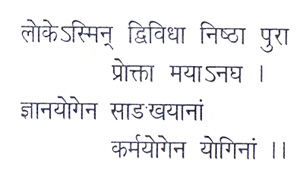
Gita, 3-3
In the course of his commentary on this verse and also earlier in the second chapter, Sankara explains the nature of jnana-yoga. He says thatjnana-yoga, the view which considers that knowledge itself is the yoga, is suited to the Sankhyas, to those who possess a clear knowledge of the Self and the not-Self, who renounce the world from the Brahmacharya, who determine the nature of the things in the light of the Vedantic wisdom, who belong to the highest class of sannyasins known as the Paramahamsas, whose thought ever dwell on Brahman only. As distinguished from this, the other path, namely karma-yoga, or the path of action, is suited to the Yogins who look upon the Self as the agent and enjoyer. It is not the case that anybody is competent to resort to jnana-yoga. While distinguishing jnana-yoga from karma-yoga, Sankara sets forth clearly the qualifications necessary for the pursuit of jnana-yoga. The qualifications are (1) the ability to distinguish between the Self and the not-Self, the ability, that is to say, to distinguish the eternal and the ephemeral, (2) renunciation of the worldly pleasures here and hereafter, (3) steady, uninterrupted contemplation on Brahman. A person who fulfills these requirements will necessarily be one who has control over the mind and body, etc., familiarly known as samadamadi-sadhanasampat. In his commentary on the very first Vedanta-sutra, Sankara mentions the fourfold equipment (sadhana-chatushtaya) that one must have in order to pursue jnana-yoga. Those who have the requisite qualifications are the Sankhyas and they alone are competent for jnana-yoga
It should not be thought that Sankara either ignores or minimises the importance of karma-yoga. The performance of karma by those who are qualified for it is useful in that it is conducive to the attainment of the purification of the mind (chitta-suddhi). Karma purifies the mind and the knowledge of the Self is manifested only in such a pure mind. That is why Sankara says: “Devotion to action is a means to the end, not directly, but only as leading to devotion to knowledge; the latter which is attained by means of devotion to action, leads to the goal directly without extraneous help.”
(Sankara’s Commentary on the Gita, 3-3)
This is again emphasised by him in his commentary on the Sutra

He points out that for the origination of knowledge karma is necessary; but once it has sprung up, it requires no help from Karma or from anything else for accomplishing the final goal. While self-control, etc. (samadamadi) are useful as the direct means, asramakarmas as enjoined by Scripture are useful as the indirect means for the origination of knowledge. Thus while Sankara fully recognizes the importance of karma-yoga in its own way, he is emphatic that the attainment of liberation which is the supreme good falls directly within the scope of jnana-yoga alone, and that nothing can vouchsafe for us this goal excepting the immediate and direct knowledge of Brahman-Atman. It is necessary at this stage to refer to the view of the Mimamsakas who think that karma is the means to liberation. They argue that the import of the entire Veda is in karma

If so, it should be said, according to them, that the highest good, viz. liberation is the result of karma alone or of karma in combination with knowledge. A critical examination of the Mimamsa view on this issue will help us to better appreciate Sankara’s position that release can be obtained through mere knowledge alone.
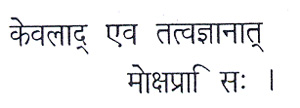
Sankara discusses the Mimamsa position on this issue in every work of his as the occasion demands in order to vindicate his position which is based on the authority of the Upanishads and refute the opposite view. For example, at the commencement of his commentary on the Taittiriya Upanishad he discusses this issue. And again towards the close of his commentary on the Sikshavalli of the Taittiriya Upanishad, he takes up this issue, enumerates the different alternatives which one can think of in the context and shows why it is impossible to accept any other alternative excepting the one which he maintains, for that alone can stand examination and meets with the approval of sruti
One can think of five alternatives in respect of karma and jnana serving as a means to liberation either independently or in combination. First, it may be said that liberation can be attained through karma alone. The second alternative is that liberation is attained through karma and jnana in combination. This combination of jnana and karma may be taken in three ways: it may be that both karma and jnana are given equal importance as means; or it may be that karma is made the principal means with knowledge as subsidiary to it; or it may be that jnana is treated as the principal means with karma as subsidiary to it. Thus the combination of karma and knowledge will give us three alternatives. Finally there is the alternative according to which liberation results from knowledge alone.
The first alternative, says Sankara, is untenable. Liberation consists in realizing the true nature of the Self as the eternal, non-dual reality. And so it cannot result from karma. It is a matter of common knowledge that anything which is produced by action is impermanent (anitya). If liberation were the result of karma then it will be impermanent and such a state is not really desirable.

Sankara in his Intro. to Taitt Up
As Suresvara puts it: “Since release is unalterably eternal, karma is not a means to that. If it were the result of Karma, like heaven, etc., it will not be eterna1.”
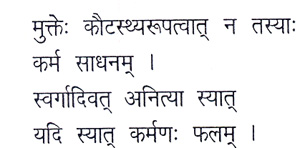
Taittiriya Vartika, verse-24
There is also another reason for rejecting this view. Karma involves duality in the form of means and end,doer and deed. The perception of duality is ignorance. Further, it is only a person who has desire performs karma. Since he is ignorant of the non-dual Self, he thinks that there are objects other than the Self which he should strive for and that there are persons for whom he should suffer in his body. “He struggles desiring something for himself, something else for his son, a third thing for his wife and so on and gets involved in the cycle of births and deaths.” (Brh. Up. Sankara’s Commentary, 4-4-12) In short, karma presupposes desire, involves duality, and is therefore a product of avidya. If so, how can it destroy avidya, the root cause of bondage and thereby cause liberation?
The futility of karma in respect of attaining release can be shown in another way. Whenever we do any action, it is for the sake of production (utpatti), or purification (samskara), or transformation (vikara), or attainment (apti). That is to say, karma can produce or purify or transform or bring within reach something. Apart from these four, a fifth use of karma cannot be thought of.
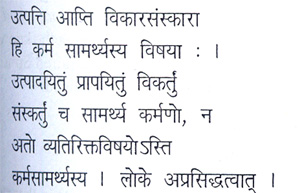
Bhr. up. 3-3-1-sankara’s Commentry
From the point of any of these four uses karma is of no use for attaining liberation. Remaining in one’s own true form is release. It consists in realizing the true nature of the Self which is ever-existent and eternal. Moksha, therefore, is not something to be produced, for it is eternal (nityatvat). It is not something to be purified, for it is bereft of all qualities and impurities (nirgunatvat, nirdoshatvat cha). There is also another reason here. It cannot be purified since it is not a means (asadhanadravyatmakatvat). Only a thing that serves as a means can be purified, as the sacrificial vessel or clarified butter by sprinkling of water and so on.

Bhr. up. 3-3-1-sankara’s Commentry
It is not something to be transformed, for it is immutable (kutasthatvat). It is not sometjing to be attained, for it is already attained as the Self of every one.

Attainment is possible only with regard to something which is different from us, which is outside us, which is not within our reach. Since liberation consists in remaining in one’s own form, since it consists in being identical with the self which is non-dual (atmasvabhavatvat ekatvat cha), there is no question of attainment in this case. Suresvara sums up the position as follows: “Every karma is for the sake of attaining the fruit not yet realized. Since the Self is already attained, karma is of no use for attaining it.” (Tait. Var. verse,18)
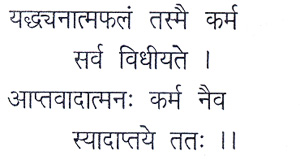
Let us now take up the view according to which the combination of knowledge and karma are given equal status leads to liberation. Even this is untenable. How is it possible to combine knowledge and karma which are opposed to each other like light and darkness? Sankara declares that the antithesis between knowledge and karma is irremovable like a mountain.

One and the same person cannot resort to the path of jnana and the path of karma at the same time. A person who adopts the path of knowledge (jnana-yoga) is said to have sankhya-buddhi; he is one who knows the Self as non-dual, eternal, and immutable, as neither an agent nor an enjoyer. On the contrary, a person who adopts the path of karma is said to have yoga-buddhi; he is one who looks upon the Self as an agent and enjoyer. The two, namely, jnana and karma are therefore quite distinct. Sankara points out that this is quite obvious from the way in which Arjuna puts the question at the beginning of the third chapter and the way in which Sri Krishna answers the question. Arjuna asks: “If it be thought by you that knowledge is superior to action, O Janardana, why then do you, O Kesava, direct me to this terrible action?” “With an apparently perplexing speech you confuse my understanding as it were. Tell me with certainty that one by which I may attain bliss.”
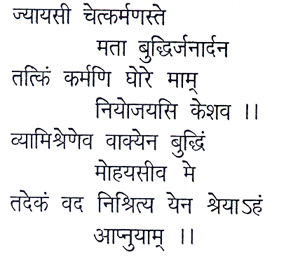
Gita, III.I-2
So Arjuna wants to know which of the two paths is intended for him, for both of them cannot be followed by one and the same person at the same time. Sri Krishna begins to answer his question by saying: “In this world a twofold path was taught by me at first. O sinless one: that of the Sankhyas by devotion to knowledge and of the Yogins by devotion to action.” (3-3)
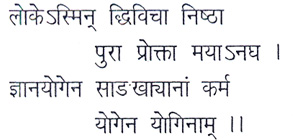
From the very distinction that is made between the two paths, it is unmistakably clear that the two are quite different and that they cannot be combined at the same time.
Nor does the fourth alternative fare better. There is absolutely no need of the assistance of karma to knowledge in the matter of attaining liberation. We have already pointed out that the scope of karma is restricted to four functions. Karma does not have any other function than these. It is not possible to say that karma assists jnana by removing the hindrance that stands in the way of attaining release. The only hindrance to the attainment of liberation is ignorance. Knowledge by its very nature is manifestation; knowledge is what illumines. Ignorance is its opposite: it is non-manifestation, it is what conceals the real nature of things. Therefore ignorance is the opposite of knowledge

Brh. Up. 3-3-1 S’s Com
Karma is not competent to remove ignorance, for it is not opposed to it. It does not matter in what way we charecterize ignorance, whether as absence of knowledge or as doubt or as erroneous knowledge. It is always removable by knowledge, but not by action in any of its forms, for there is no contradiction between ignorance and karma.
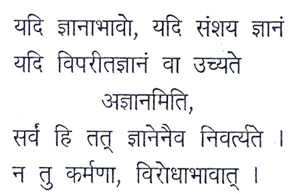
Brh. Up. 3-3-1 S’s Com
If it be said that the assistance of karma is in respect of purification of the mind, the Advaitin welcomes it. Therefore it is only through knowledge and through knowledge alone that the highest good, viz., liberation is attained.

Just as a man is really free only when he knows the Self and remains in his own form, so also a man has real strength (viryam) only when he knows the inward Self; and it is through the strength of Self-knowledge that he attains immortality. A text from the Kena Upanishad is relevant in this context. It says: “It is through the knowledge of one’s own Self that strength is acquired. So it is through knowledge, that immortality is attained.”
Commenting on this text, Sri Sankara says that the strength got from wealth, friend, incantation, medicine, austerity, or Yoga cannot conquer death, for it is produced by impermanent things. But the strength, consequent on the knowledge of the Self, is acquired through the Self alone and not through anything else. Thus, since the strength resulting from the knowledge of the Self is independent of any means of acquisition, that strength alone is able to conquer death.”
The places of jnana-yoga and karma-yoga in the scheme of discipline or sadhana are well decided according to their individual intrinsic nature. To begin with, karma-yoga aids integration of the agitated sadhaka. This integration is a preliminary condition for establishing oneself in Jnana-yoga. Finally jnana-yoga leads one to liberation


























